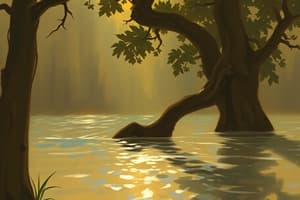Podcast
Questions and Answers
What is an example of indigenous art during the pre-colonial period in the Philippines?
What is an example of indigenous art during the pre-colonial period in the Philippines?
- American-style sculptures
- Banaue Rice Terraces (correct)
- Golden armlet from San Fernando
- Spanish-inspired paintings
Which material was commonly used for creating the rice god statues found in Batad during the pre-colonial period?
Which material was commonly used for creating the rice god statues found in Batad during the pre-colonial period?
- Gold and silver
- Clay, stone, and wood (correct)
- Glass and marble
- Bronze and copper
What art form is associated with the Mangyan tribes during the pre-colonial period?
What art form is associated with the Mangyan tribes during the pre-colonial period?
- Creating intricate weaponry
- Painting elaborate murals
- Sculpting clay figurines
- Weaving textiles with natural dyes (correct)
Which era marked the arrival of Western colonizers in the Philippines, influencing art in the region?
Which era marked the arrival of Western colonizers in the Philippines, influencing art in the region?
During which period did the Kalinga blacksmiths craft weaponry from iron and steel as part of their artistic tradition?
During which period did the Kalinga blacksmiths craft weaponry from iron and steel as part of their artistic tradition?
Which artistic movement was spearheaded by the Thirteen Moderns in the Philippines?
Which artistic movement was spearheaded by the Thirteen Moderns in the Philippines?
Who is known for championing contemporary indigenous patterns and colors in Philippine folk art?
Who is known for championing contemporary indigenous patterns and colors in Philippine folk art?
What European aesthetic sensibilities influenced Filipino artists during the Spanish colonial period?
What European aesthetic sensibilities influenced Filipino artists during the Spanish colonial period?
Which artwork depicting religious themes became a symbol of the Spanish colonial era in the Philippines?
Which artwork depicting religious themes became a symbol of the Spanish colonial era in the Philippines?
Who were two notable artists who gained international recognition for presenting a uniquely Philippine perspective within European painting genres during the American colonial period?
Who were two notable artists who gained international recognition for presenting a uniquely Philippine perspective within European painting genres during the American colonial period?
Flashcards are hidden until you start studying
Study Notes
Visual Arts in the Philippines: A Journey Through Time
Throughout its storied history spanning thousands of years, the archipelago now known as the Philippines has produced a wealth of visual arts expressing unique cultural narratives shaped by diverse influences. To appreciate the nation's artistic heritage, we will delve into various eras—from prehistoric times through the arrival of Western colonizers to modern innovations inspired by local traditions.
Pre-Colonial Art
The beginnings of Philippine visual arts can be traced back to around 50,000 BC with cave paintings discovered at Tabon Cave, showcasing early human interaction with their environment. Rice paddies transformed into intricate terrace systems, leading to the creation of awe-inspiring rice god statues made from clay, stone, and wood like those found in Batad. Wealthier communities erected burial mounds where deceased lords were buried alongside luxurious goods and ancestral figures such as the famous golden armlet from San Fernando, La Union.
Indigenous Art Forms
Indigenous art flourished during this period, with each ethnic group developing distinctive styles reflective of their beliefs and lifestyles. For instance, Mangyan tribes produced stunningly woven textiles using natural dyes extracted from native plants; the Ifugao created the breathtaking Banaue Rice Terraces; and Kalinga blacksmiths crafted exquisite weaponry from iron and steel.
Spanish Colonial Art
In the mid-sixteenth century, Spain arrived, bringing along Catholicism and European aesthetic sensibilities. This fusion led to Baroque masterpieces painted by Filipino artists like Diego Silang, depicting religious themes like the martyrdom of St. Lorenzo Ruiz. Influenced by European techniques and materials, locals also began creating ceramics, shoes, silverware, furniture, and wrought-iron pieces. Señor Santo Niño de Cebú, one of the most revered images in the country, is a remarkable example of this era.
American Colonial Art
Following the American occupation in 1898, a new wave of creativity emerged. Notable artists like Juan Luna and Felix Resurrección Hidalgo gained international acclaim for presenting a uniquely Philippine perspective within European painting genres. Meanwhile, folk art, including works by Vito Selma and Vicente Manansala, who championed contemporary indigenous patterns and colors, expanded beyond traditional boundaries.
Contemporary Art
From the 20th century until today, art in the Philippines continues to thrive, driven by both tradition and innovation. Some notable movements include abstract expressionism spearheaded by the Thirteen Moderns, minimalist realism captured by artists like Napoleon Abueva, and conceptual installations pioneered by BenCab and Jose John Santos III. Fascinating contemporary galleries have since opened across major cities like Metropolitan Manila, Cebu City, Davao, and Baguio, providing platforms for emerging talents while preserving past achievements.
In conclusion, the visual arts of the Philippines chronicle triumphant struggles and resilient cultures. From ancient enigmas hidden deep inside caves to grandiose expressions shaped under foreign rule, the nation's legacy remains steadfast in showcasing originality amidst adversity. Today, these creative roots continue to bear fruit through bold experimentation, dynamic interplay between old and new, all effortlessly woven together in a kaleidoscope of colorful stories waiting to unfold.
Studying That Suits You
Use AI to generate personalized quizzes and flashcards to suit your learning preferences.




